VOLVO XC90 TWIN ENGINE 2019 Owners Manual
Manufacturer: VOLVO, Model Year: 2019, Model line: XC90 TWIN ENGINE, Model: VOLVO XC90 TWIN ENGINE 2019Pages: 697, PDF Size: 10.33 MB
Page 311 of 697
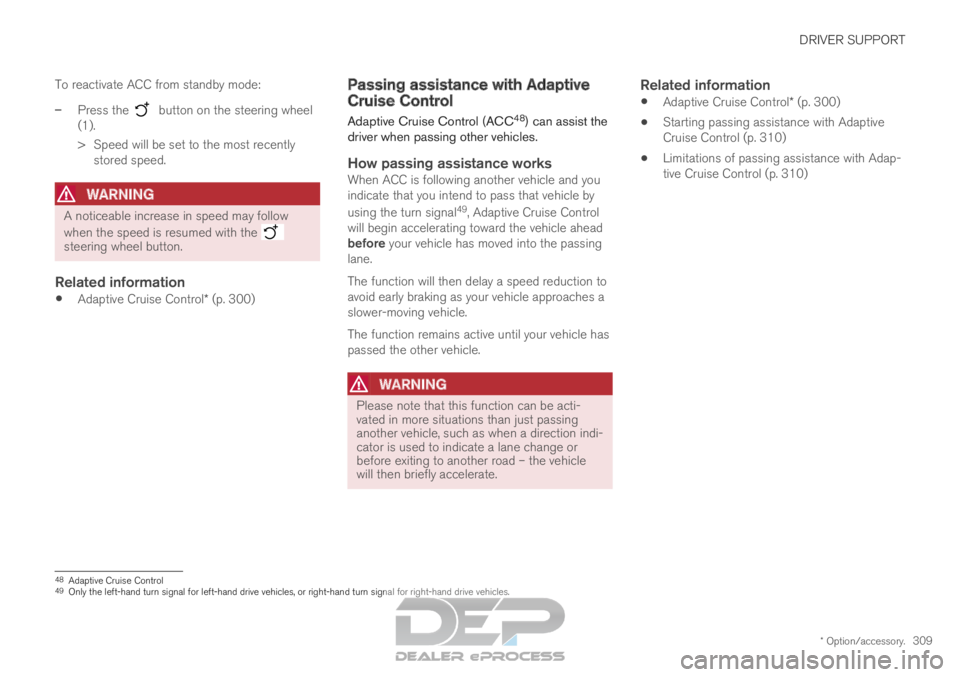
DRIVER SUPPORT
* Option/accessory.309
To reactivate ACC from standby mode:
– Press the button on the steering wheel
(1).
>
Speed will be set to the most recently
stored speed.
WARNING A noticeable increase in speed may follow
when the speed is resumed with the
steering wheel button.
Related information
Adaptive Cruise Control* (p. 300) Passing assistance with Adaptive
Cruise Control
Adaptive Cruise Control (ACC
48
) can assist the
driver when passing other vehicles.
How passing assistance worksWhen ACC is following another vehicle and you
indicate that you intend to pass that vehicle by
using the turn signal 49
, Adaptive Cruise Control
will begin accelerating toward the vehicle ahead
before your vehicle has moved into the passing
lane.
The function will then delay a speed reduction to
avoid early braking as your vehicle approaches a
slower-moving vehicle.
The function remains active until your vehicle has
passed the other vehicle.
WARNING Please note that this function can be acti-
vated in more situations than just passing
another vehicle, such as when a direction indi-
cator is used to indicate a lane change or
before exiting to another road – the vehicle
will then briefly accelerate.
Related information
Adaptive Cruise Control* (p. 300)
Starting passing assistance with Adaptive
Cruise Control (p. 310)
Limitations of passing assistance with Adap-
tive Cruise Control (p. 310) 48
Adaptive Cruise Control
49 Only the left-hand turn signal for left-hand drive vehicles, or right-ha\
nd turn signal for right-hand drive vehicles.
Page 312 of 697
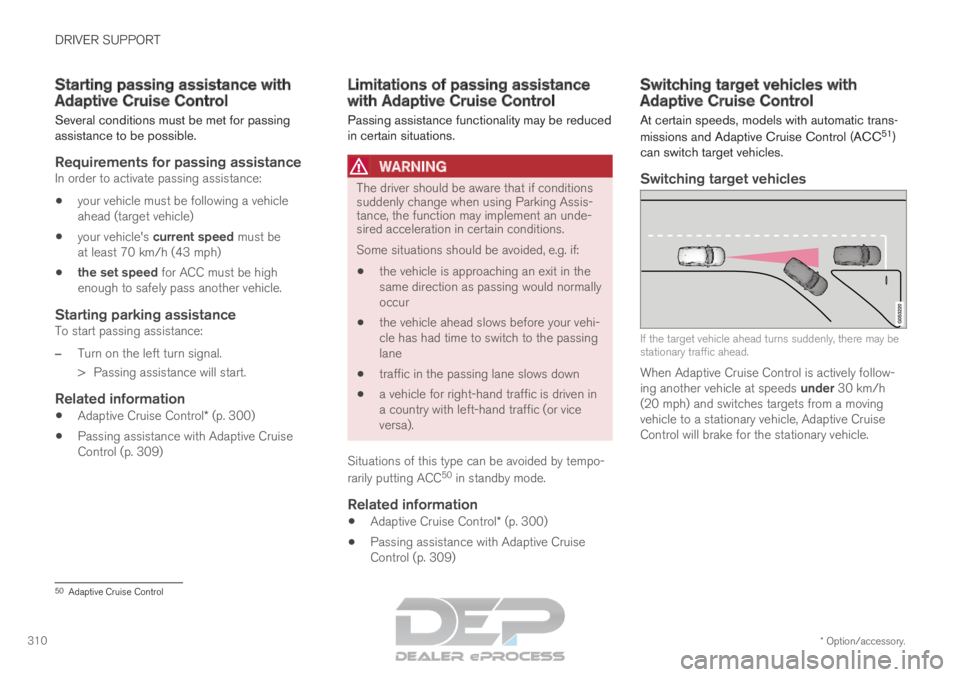
DRIVER SUPPORT
* Option/accessory.
310 Starting passing assistance with
Adaptive Cruise Control
Several conditions must be met for passing
assistance to be possible.
Requirements for passing assistanceIn order to activate passing assistance:
your vehicle must be following a vehicle
ahead (target vehicle)
your vehicle's current speed must be
at least 70 km/h (43 mph)
the set speed for ACC must be high
enough to safely pass another vehicle.
Starting parking assistanceTo start passing assistance:
–
Turn on the left turn signal.
>
Passing assistance will start.
Related information
Adaptive Cruise Control* (p. 300)
Passing assistance with Adaptive Cruise
Control (p. 309) Limitations of passing assistance
with Adaptive Cruise Control
Passing assistance functionality may be reduced
in certain situations.
WARNING The driver should be aware that if conditions
suddenly change when using Parking Assis-
tance, the function may implement an unde-
sired acceleration in certain conditions.
Some situations should be avoided, e.g. if:
the vehicle is approaching an exit in the
same direction as passing would normally
occur
the vehicle ahead slows before your vehi-
cle has had time to switch to the passing
lane
traffic in the passing lane slows down
a vehicle for right-hand traffic is driven in
a country with left-hand traffic (or vice
versa).
Situations of this type can be avoided by tempo-
rarily putting ACC 50
in standby mode.
Related information
Adaptive Cruise Control* (p. 300)
Passing assistance with Adaptive Cruise
Control (p. 309) Switching target vehicles with
Adaptive Cruise Control
At certain speeds, models with automatic trans-
missions and Adaptive Cruise Control (ACC 51
)
can switch target vehicles.
Switching target vehicles If the target vehicle ahead turns suddenly, there may be
stationary traffic ahead.
When Adaptive Cruise Control is actively follow-
ing another vehicle at speeds under 30 km/h
(20 mph) and switches targets from a moving
vehicle to a stationary vehicle, Adaptive Cruise
Control will brake for the stationary vehicle. 50
Adaptive Cruise Control
Page 313 of 697
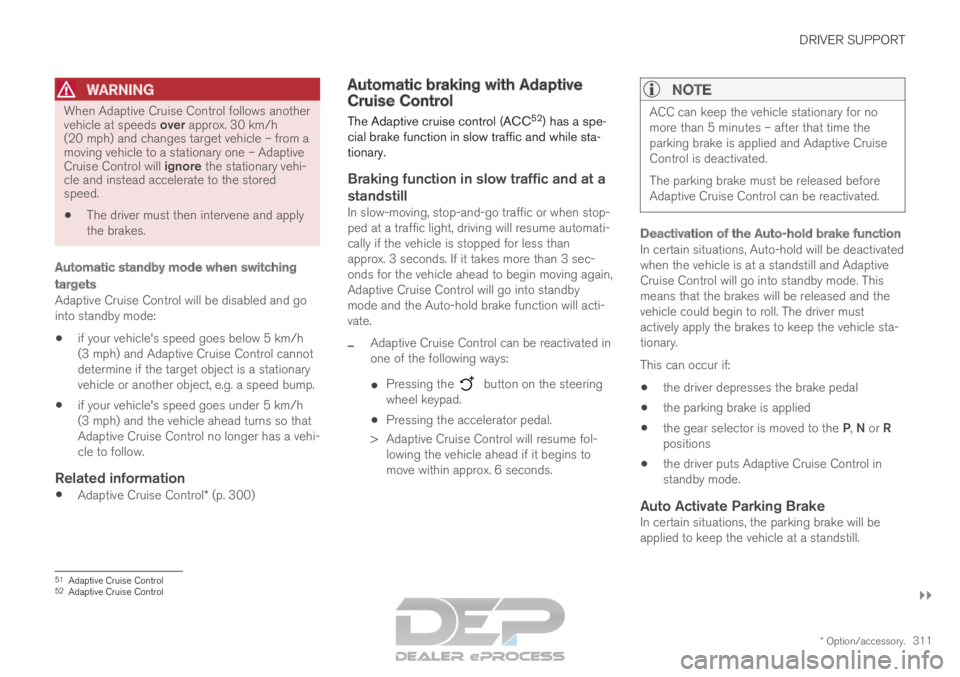
DRIVER SUPPORT
}}
* Option/accessory. 311
WARNINGWhen Adaptive Cruise Control follows another
vehicle at speeds over approx. 30 km/h
(20 mph) and changes target vehicle – from a
moving vehicle to a stationary one – Adaptive
Cruise Control will ignore the stationary vehi-
cle and instead accelerate to the stored
speed.
The driver must then intervene and apply
the brakes.
Automatic standby mode when switching
targets
Adaptive Cruise Control will be disabled and go
into standby mode:
if your vehicle's speed goes below 5 km/h
(3 mph) and Adaptive Cruise Control cannot
determine if the target object is a stationary
vehicle or another object, e.g. a speed bump.
if your vehicle's speed goes under 5 km/h
(3 mph) and the vehicle ahead turns so that
Adaptive Cruise Control no longer has a vehi-
cle to follow.
Related information
Adaptive Cruise Control* (p. 300) Automatic braking with Adaptive
Cruise Control
The Adaptive cruise control (ACC
52
) has a spe-
cial brake function in slow traffic and while sta-
tionary.
Braking function in slow traffic and at a
standstill
In slow-moving, stop-and-go traffic or when stop-
ped at a traffic light, driving will resume automati-
cally if the vehicle is stopped for less than
approx. 3 seconds. If it takes more than 3 sec-
onds for the vehicle ahead to begin moving again,
Adaptive Cruise Control will go into standby
mode and the Auto-hold brake function will acti-
vate.
– Adaptive Cruise Control can be reactivated in
one of the following ways:
Pressing the button on the steering
wheel keypad.
Pressing the accelerator pedal.
>
Adaptive Cruise Control will resume fol-
lowing the vehicle ahead if it begins to
move within approx. 6 seconds.
NOTE ACC can keep the vehicle stationary for no
more than 5 minutes – after that time the
parking brake is applied and Adaptive Cruise
Control is deactivated.
The parking brake must be released before
Adaptive Cruise Control can be reactivated.
Deactivation of the Auto-hold brake function
In certain situations, Auto-hold will be deactivated
when the vehicle is at a standstill and Adaptive
Cruise Control will go into standby mode. This
means that the brakes will be released and the
vehicle could begin to roll. The driver must
actively apply the brakes to keep the vehicle sta-
tionary.
This can occur if:
the driver depresses the brake pedal
the parking brake is applied
the gear selector is moved to the
P
, N
or R
positions
the driver puts Adaptive Cruise Control in
standby mode.
Auto Activate Parking BrakeIn certain situations, the parking brake will be
applied to keep the vehicle at a standstill. 51
Adaptive Cruise Control
52 Adaptive Cruise Control
Page 314 of 697
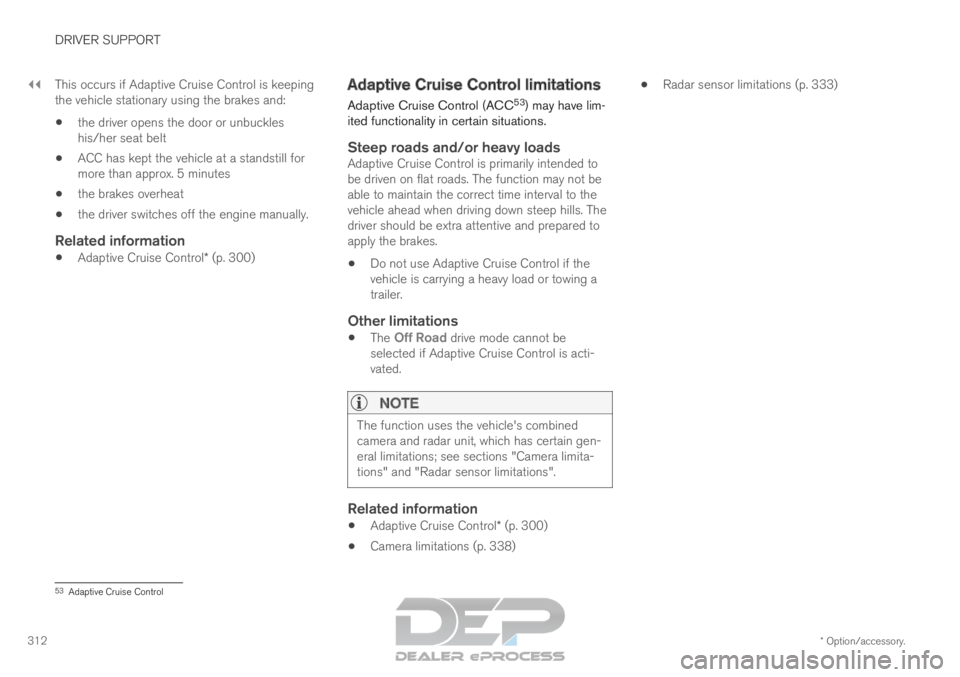
||DRIVER SUPPORT
* Option/accessory.
312 This occurs if Adaptive Cruise Control is keeping
the vehicle stationary using the brakes and:
the driver opens the door or unbuckles
his/her seat belt
ACC has kept the vehicle at a standstill for
more than approx. 5 minutes
the brakes overheat
the driver switches off the engine manually.
Related information
Adaptive Cruise Control* (p. 300) Adaptive Cruise Control limitations
Adaptive Cruise Control (ACC 53
) may have lim-
ited functionality in certain situations.
Steep roads and/or heavy loadsAdaptive Cruise Control is primarily intended to
be driven on flat roads. The function may not be
able to maintain the correct time interval to the
vehicle ahead when driving down steep hills. The
driver should be extra attentive and prepared to
apply the brakes.
Do not use Adaptive Cruise Control if the
vehicle is carrying a heavy load or towing a
trailer.
Other limitations
The
Off Road drive mode cannot be
selected if Adaptive Cruise Control is acti-
vated.
NOTE The function uses the vehicle's combined
camera and radar unit, which has certain gen-
eral limitations; see sections "Camera limita-
tions" and "Radar sensor limitations".
Related information
Adaptive Cruise Control* (p. 300)
Camera limitations (p. 338)
Radar sensor limitations (p. 333) 53
Adaptive Cruise Control
Page 315 of 697
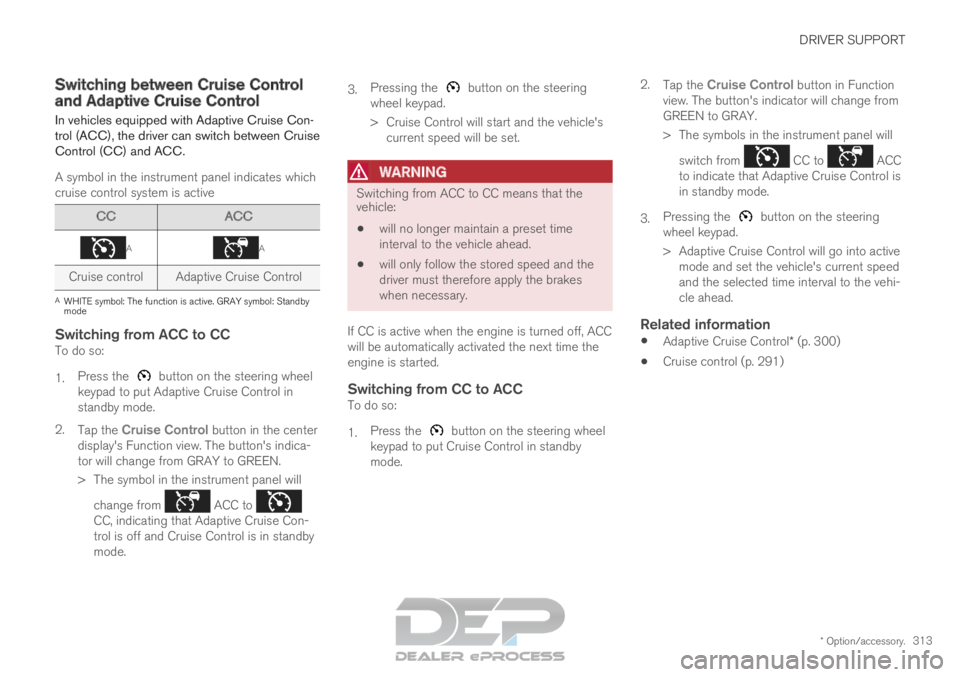
DRIVER SUPPORT
* Option/accessory.313
Switching between Cruise Control
and Adaptive Cruise Control
In vehicles equipped with Adaptive Cruise Con-
trol (ACC), the driver can switch between Cruise
Control (CC) and ACC.
A symbol in the instrument panel indicates which
cruise control system is active CC
ACCA A
Cruise control
Adaptive Cruise Control A
WHITE symbol: The function is active. GRAY symbol: Standby
mode
Switching from ACC to CCTo do so:
1. Press the button on the steering wheel
keypad to put Adaptive Cruise Control in
standby mode.
2. Tap the Cruise Control button in the center
display's Function view. The button's indica-
tor will change from GRAY to GREEN.
>
The symbol in the instrument panel will
change from ACC to
CC, indicating that Adaptive Cruise Con-
trol is off and Cruise Control is in standby
mode. 3.
Pressing the button on the steering
wheel keypad.
>
Cruise Control will start and the vehicle's
current speed will be set.
WARNING Switching from ACC to CC means that the
vehicle:
will no longer maintain a preset time
interval to the vehicle ahead.
will only follow the stored speed and the
driver must therefore apply the brakes
when necessary.
If CC is active when the engine is turned off, ACC
will be automatically activated the next time the
engine is started.
Switching from CC to ACCTo do so:
1. Press the button on the steering wheel
keypad to put Cruise Control in standby
mode. 2.
Tap the Cruise Control button in Function
view. The button's indicator will change from
GREEN to GRAY.
>
The symbols in the instrument panel will
switch from CC to ACC
to indicate that Adaptive Cruise Control is
in standby mode.
3. Pressing the button on the steering
wheel keypad.
>
Adaptive Cruise Control will go into active
mode and set the vehicle's current speed
and the selected time interval to the vehi-
cle ahead.
Related information
Adaptive Cruise Control* (p. 300)
Cruise control (p. 291)
Page 316 of 697
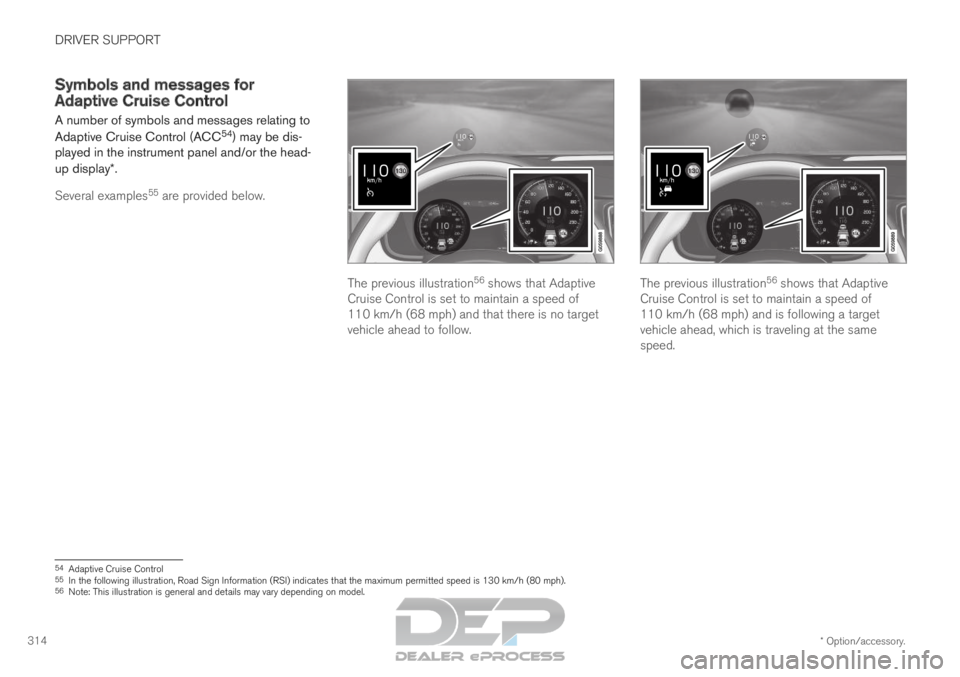
DRIVER SUPPORT
* Option/accessory.
314 Symbols and messages for
Adaptive Cruise Control
A number of symbols and messages relating to
Adaptive Cruise Control (ACC 54
) may be dis-
played in the instrument panel and/or the head-
up display*.
Several examples 55
are provided below. The previous illustration
56
shows that Adaptive
Cruise Control is set to maintain a speed of
110 km/h (68 mph) and that there is no target
vehicle ahead to follow. The previous illustration
56
shows that Adaptive
Cruise Control is set to maintain a speed of
110 km/h (68 mph) and is following a target
vehicle ahead, which is traveling at the same
speed. 54
Adaptive Cruise Control
55 In the following illustration, Road Sign Information (RSI) indicates t\
hat the maximum permitted speed is 130 km/h (80 mph).
56 Note: This illustration is general and details may vary depending on mod\
el.
Page 317 of 697
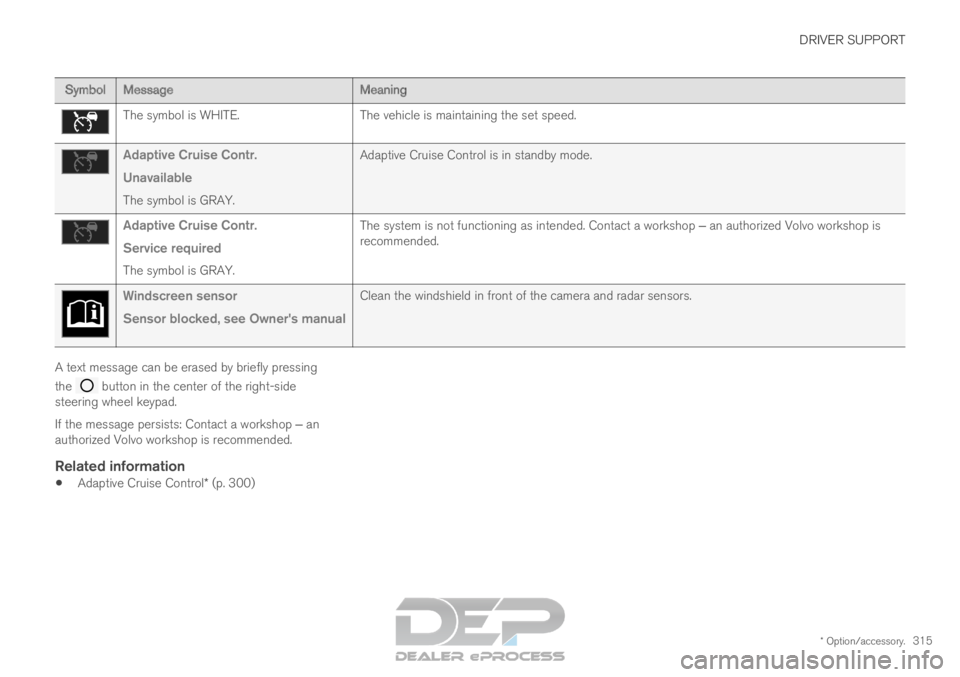
DRIVER SUPPORT
* Option/accessory.315Symbol
Message MeaningThe symbol is WHITE.
The vehicle is maintaining the set speed.Adaptive Cruise Contr.
Unavailable
The symbol is GRAY. Adaptive Cruise Control is in standby mode.Adaptive Cruise Contr.
Service required
The symbol is GRAY. The system is not functioning as intended. Contact a workshop ‒ an authorized Volvo workshop is
recommended. Windscreen sensor
Sensor blocked, see Owner's manual
Clean the windshield in front of the camera and radar sensors.A text message can be erased by briefly pressing
the
button in the center of the right-side
steering wheel keypad.
If the message persists: Contact a workshop ‒ an
authorized Volvo workshop is recommended.
Related information
Adaptive Cruise Control* (p. 300)
Page 318 of 697
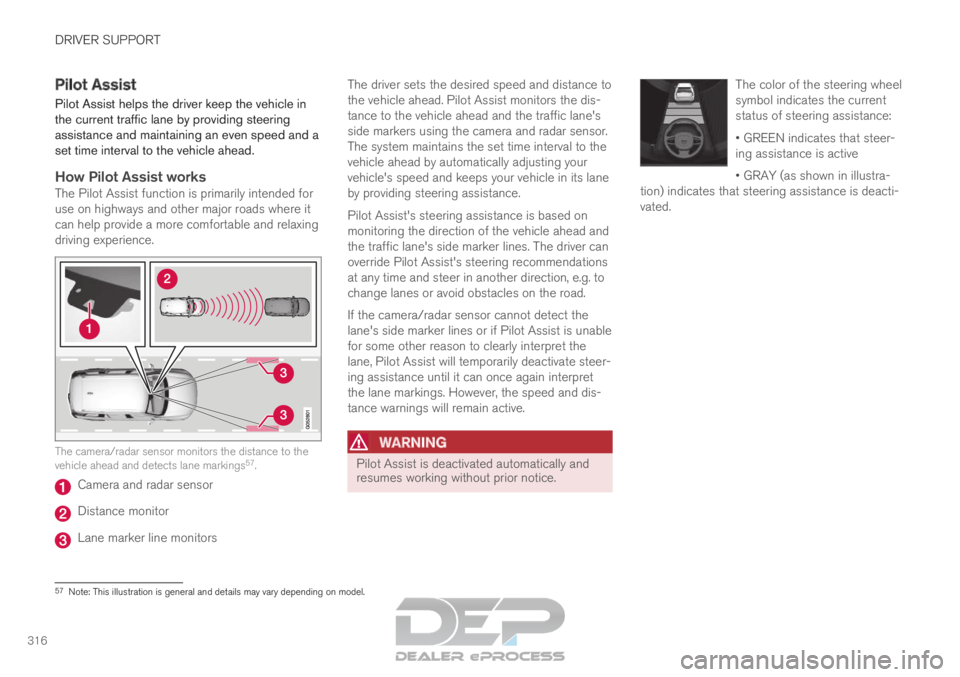
DRIVER SUPPORT
316Pilot Assist
Pilot Assist helps the driver keep the vehicle in
the current traffic lane by providing steering
assistance and maintaining an even speed and a
set time interval to the vehicle ahead.
How Pilot Assist worksThe Pilot Assist function is primarily intended for
use on highways and other major roads where it
can help provide a more comfortable and relaxing
driving experience. The camera/radar sensor monitors the distance to the
vehicle ahead and detects lane markings
57
. Camera and radar sensor
Distance monitor
Lane marker line monitors The driver sets the desired speed and distance to
the vehicle ahead. Pilot Assist monitors the dis-
tance to the vehicle ahead and the traffic lane's
side markers using the camera and radar sensor.
The system maintains the set time interval to the
vehicle ahead by automatically adjusting your
vehicle's speed and keeps your vehicle in its lane
by providing steering assistance.
Pilot Assist's steering assistance is based on
monitoring the direction of the vehicle ahead and
the traffic lane's side marker lines. The driver can
override Pilot Assist's steering recommendations
at any time and steer in another direction, e.g. to
change lanes or avoid obstacles on the road.
If the camera/radar sensor cannot detect the
lane's side marker lines or if Pilot Assist is unable
for some other reason to clearly interpret the
lane, Pilot Assist will temporarily deactivate steer-
ing assistance until it can once again interpret
the lane markings. However, the speed and dis-
tance warnings will remain active.
WARNING
Pilot Assist is deactivated automatically and
resumes working without prior notice. The color of the steering wheel
symbol indicates the current
status of steering assistance:
• GREEN indicates that steer-
ing assistance is active
• GRAY (as shown in illustra-
tion) indicates that steering assistance is deacti-
vated. 57
Note: This illustration is general and details may vary depending on mod\
el.
Page 319 of 697
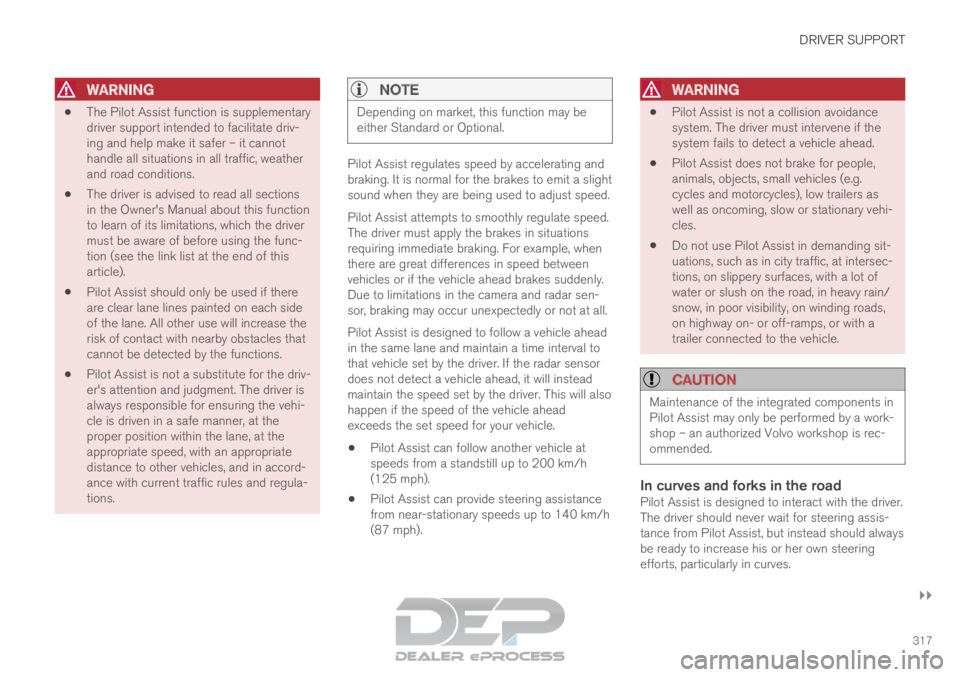
DRIVER SUPPORT
}}
317
WARNING
The Pilot Assist function is supplementary
driver support intended to facilitate driv-
ing and help make it safer – it cannot
handle all situations in all traffic, weather
and road conditions.
The driver is advised to read all sections
in the Owner's Manual about this function
to learn of its limitations, which the driver
must be aware of before using the func-
tion (see the link list at the end of this
article).
Pilot Assist should only be used if there
are clear lane lines painted on each side
of the lane. All other use will increase the
risk of contact with nearby obstacles that
cannot be detected by the functions.
Pilot Assist is not a substitute for the driv-
er's attention and judgment. The driver is
always responsible for ensuring the vehi-
cle is driven in a safe manner, at the
proper position within the lane, at the
appropriate speed, with an appropriate
distance to other vehicles, and in accord-
ance with current traffic rules and regula-
tions.NOTE Depending on market, this function may be
either Standard or Optional.
Pilot Assist regulates speed by accelerating and
braking. It is normal for the brakes to emit a slight
sound when they are being used to adjust speed.
Pilot Assist attempts to smoothly regulate speed.
The driver must apply the brakes in situations
requiring immediate braking. For example, when
there are great differences in speed between
vehicles or if the vehicle ahead brakes suddenly.
Due to limitations in the camera and radar sen-
sor, braking may occur unexpectedly or not at all.
Pilot Assist is designed to follow a vehicle ahead
in the same lane and maintain a time interval to
that vehicle set by the driver. If the radar sensor
does not detect a vehicle ahead, it will instead
maintain the speed set by the driver. This will also
happen if the speed of the vehicle ahead
exceeds the set speed for your vehicle.
Pilot Assist can follow another vehicle at
speeds from a standstill up to 200 km/h
(125 mph).
Pilot Assist can provide steering assistance
from near-stationary speeds up to 140 km/h
(87 mph).WARNING
Pilot Assist is not a collision avoidance
system. The driver must intervene if the
system fails to detect a vehicle ahead.
Pilot Assist does not brake for people,
animals, objects, small vehicles (e.g.
cycles and motorcycles), low trailers as
well as oncoming, slow or stationary vehi-
cles.
Do not use Pilot Assist in demanding sit-
uations, such as in city traffic, at intersec-
tions, on slippery surfaces, with a lot of
water or slush on the road, in heavy rain/
snow, in poor visibility, on winding roads,
on highway on- or off-ramps, or with a
trailer connected to the vehicle.
CAUTION Maintenance of the integrated components in
Pilot Assist may only be performed by a work-
shop – an authorized Volvo workshop is rec-
ommended.
In curves and forks in the roadPilot Assist is designed to interact with the driver.
The driver should never wait for steering assis-
tance from Pilot Assist, but instead should always
be ready to increase his or her own steering
efforts, particularly in curves.
Page 320 of 697
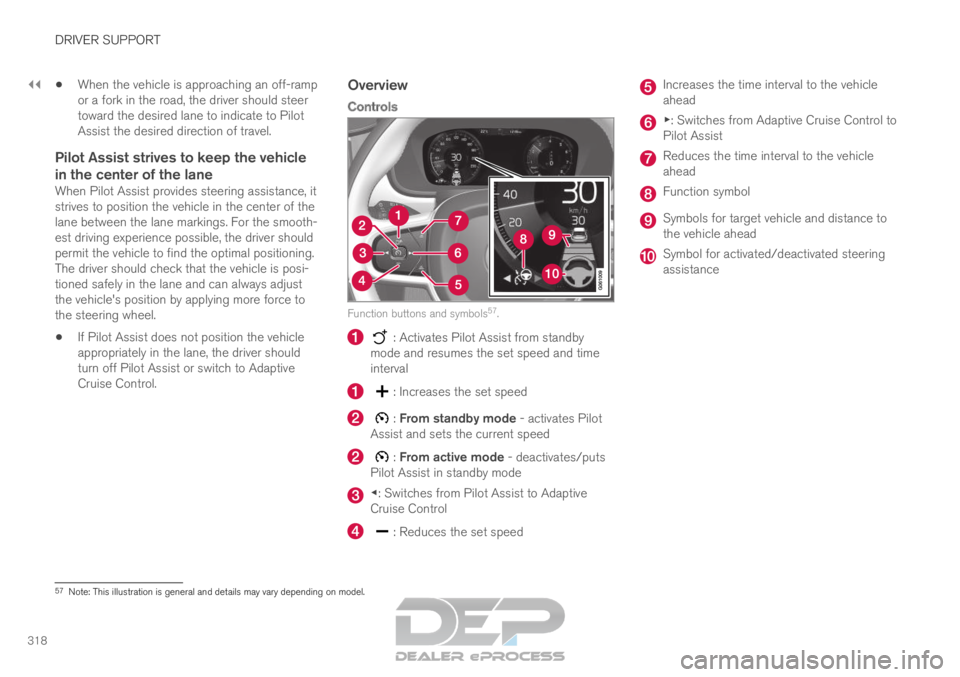
||DRIVER SUPPORT
318
When the vehicle is approaching an off-ramp
or a fork in the road, the driver should steer
toward the desired lane to indicate to Pilot
Assist the desired direction of travel.
Pilot Assist strives to keep the vehicle
in the center of the lane
When Pilot Assist provides steering assistance, it
strives to position the vehicle in the center of the
lane between the lane markings. For the smooth-
est driving experience possible, the driver should
permit the vehicle to find the optimal positioning.
The driver should check that the vehicle is posi-
tioned safely in the lane and can always adjust
the vehicle's position by applying more force to
the steering wheel.
If Pilot Assist does not position the vehicle
appropriately in the lane, the driver should
turn off Pilot Assist or switch to Adaptive
Cruise Control.
Overview
Controls Function buttons and symbols
57
. : Activates Pilot Assist from standby
mode and resumes the set speed and time
interval : Increases the set speed
: From standby mode - activates Pilot
Assist and sets the current speed : From active mode - deactivates/puts
Pilot Assist in standby mode ◀: Switches from Pilot Assist to Adaptive
Cruise Control
: Reduces the set speed Increases the time interval to the vehicle
ahead
▶: Switches from Adaptive Cruise Control to
Pilot Assist
Reduces the time interval to the vehicle
ahead
Function symbol
Symbols for target vehicle and distance to
the vehicle ahead
Symbol for activated/deactivated steering
assistance
57
Note: This illustration is general and details may vary depending on mod\
el.